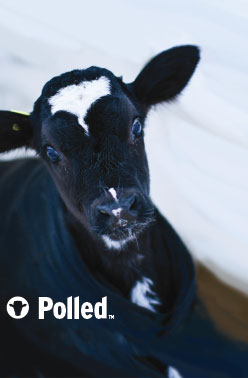
For many producers who have grown up either avoiding recessive traits (Mulefoot, BLAD, CVM and most recently HCD) or actually selecting for them (red factor), it is hard to get your head around the fact that the horned gene is actually recessive. In other words, the polled gene is dominant. It would be the equivalent to taking a red cow family and turning it black. Dominant traits like the polled gene can be incorporated into a population quickly. Even bulls that carry only one copy of the gene will generate 50% polled offspring in the first generation!
Heterozygous Polled
When a bull with just one copy of the polled gene is bred to a horned population, 50% of the resulting calves in the first generation will be polled. This type of bull is called “heterozygous polled”. In generation two, if another heterozygous polled bull is used again, now 75% of the resulting animals will be polled – 50% of the total will carry 1 copy of the gene and now 25% will already carry two copies. The point is progress toward a polled population can move swiftly.

Homozygous Polled
An animal that has inherited two copies of the polled gene is considered to be “homozygous polled”. A homozygous polled bull will transmit the polled gene to all offspring, so even when used on a 100% horned population, the result will be 100% of the offspring being polled in generation one. In this case, the horned gene becomes equivalent to the recessive gene like red factor. Even though a black bull mated to a 100% red population will result in 100% black animals in generation one, all those animals will still carry the red gene, meaning when a Red bull is used in the following generation, 50% of the calves will be red. Similarly, if a horned bull would be used in generation two following usage of a homozygous polled bull, 50% of the resulting animals would revert to horned.
Better Options for Polled
There are a number of breeders who sought to incorporate the polled gene into a top cow family to create new marketing opportunities. Still, in the early going resulting polled options typically came with a caveat that sacrifices to LPI or TPI would need to be made. Many decided that the sacrifice was not worth it. All that has changed as today we have some excellent options for producers who would like to eliminate the need to dehorn calves.
Bulls like Adagio-P with an impressive 3302 LPI, or Charles-P with 2644 TPI demonstrate that those who may have decided to wait until better genetic options exist can now jump in. There is no sacrifice to be made on genetic quality with Heterozygous polled sires currently available, and even better options will continue to join the lineup. While some producers prefer to use homozygous polled bulls where 100% of the calves will be horn-free (so that there is no need to debate if a calf needs to be dehorned or not), there is still a gap between the genetic caliber of bulls, however a bull like Skittles-PP with 2852 LPI is a reasonable option to consider.
 The clear message in a world increasingly becoming engaged in how animal agriculture is practiced is that the best way to dehorn animals is at conception. In reality once the commitment is made the process toward a polled herd will happen quickly. No one enjoys dehorning calves – selecting for polled delivers immediate benefits.
The clear message in a world increasingly becoming engaged in how animal agriculture is practiced is that the best way to dehorn animals is at conception. In reality once the commitment is made the process toward a polled herd will happen quickly. No one enjoys dehorning calves – selecting for polled delivers immediate benefits.



Leave A Comment
You must be logged in to post a comment.